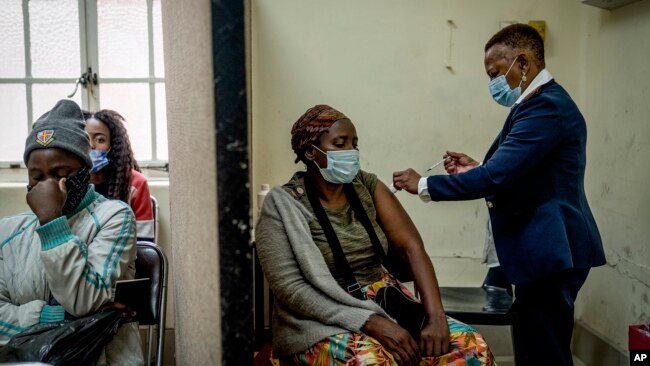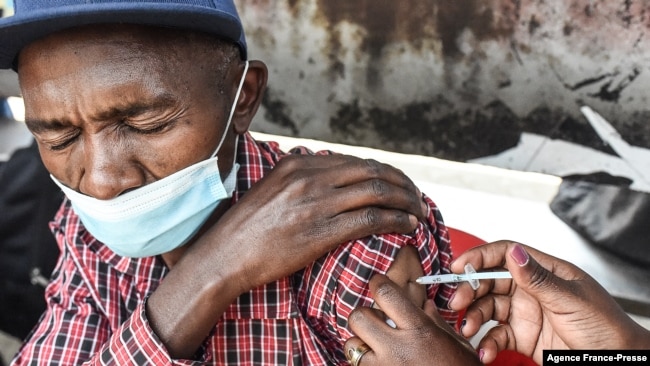アフリカにおけるワクチン接種の問題点とは?
オミクロン 株が世界を不安に陥れています。
そんな中、この記事には目が行きます。
何が起こっているのでしょうか?
VOAで英語を学び、アフリカの問題点を聴いてみましょう!!
コロナワクチン届くも、アフリカではワクチン接種に問題あり(和訳)
COVID Shots Arrive, But Africa Has Problems with Vaccination
December 11, 2021
アフリカではCOVID-19ワクチンの供給が増えています。しかし、アフリカ全土の人々にワクチンを投与することは困難です。
医療専門家は、アフリカでのワクチン接種キャンペーンを成功させることが、世界的なパンデミックを終わらせるために重要であると述べています。アフリカではワクチン接種率が低いため、南アフリカで広まっているオミクロンのように、ウイルスが変化するリスクが高くなっています。
世界保健機関によると、アフリカの人口の7.5%に相当する1億200万人が完全にワクチンを接種しているとのことです。
アフリカ諸国の政府は、今年のワクチン供給の増加を繰り返し訴えています。しかし、富裕国による生産制限や余分なワクチンの保管などにより、最近まで供給が厳しく制限されていました。
アフリカの一部の地域では、資金、医療従事者、機材の不足が、すでにワクチン接種キャンペーンに問題を引き起こしていました。専門家は、今後数週間のうちに予想されるワクチンの増加により、これらの弱点がさらに明らかになる可能性があると警告しています。
これまでにアフリカ大陸に到着したワクチンの約40%は使用されていません。この情報は、非営利の政策機関であるTony Blair Institute for Global Changeから得たものです。
同研究所によると、今後数ヶ月の間に予想される供給量に追いつくためには、ワクチンの使用率を現在の4倍にする必要があるとのことです。
ワクチン接種率はアフリカ各地で大きく異なります。比較的小さな国や北アフリカの医療システムでは、より大きな成功を収めているところもあります。
西アフリカの沖合に位置し、人口約60万人のカーボベルデでは、成人の約65%にワクチンを接種しています。
人口約9,000万人の中央アフリカのコンゴ民主共和国では、0.1%となっています。
ケニアでは、数ヶ月にわたって供給が滞っていましたが、ここ数週間で500万人分近くのワクチンを受け取りました。
ウィリス・アクワレ氏は、政府のCOVID-19ワクチン対応チームの責任者です。アクワレ氏によると、ケニアでは12月1日に過去最高の11万人にワクチンを接種しており、今後1ヶ月間はこの割合を維持することを目指しています。これにより、4,700万人の人口のうち、1,000万人がワクチン接種を受けたことになると述べています。
しかし、ケニアの首都ナイロビから南西に約270キロ離れた田舎のセケナニ保健センターは、多くの困難に直面しています。
このセンターでは、先月からCOVID-19の予防接種を開始しました。センターで働くジェラルド・イアイレさんによると、センターではワクチンが不足しがちで、頼りになる冷蔵庫が1台しかないそうです。この冷蔵庫は他のワクチンにも使われています。
ワクチンを地域に運ぶにはバイクが必要です。多くの人々は貧しく、医療機関に行くための費用を支払うことができません。
イアイルさんは地元の役人に移動式ワクチン接種の支援を求めましたが、返事はありませんでした。
「私たちが行くのではなく、地域の人たちに来てもらうしかありません」と彼は言います。
中央アフリカのカメルーンでは、4月に予防接種キャンペーンを開始したときは、244の予防接種センターがありました。今では1,000のセンターがあると、カメルーンの予防接種プログラムの副責任者は言います。
しかし、医療従事者や政府関係者によると、停電や労働者の不足により、ワクチンの有用性が脅かされているとのことです。
レオナルド・クアディオ氏は、カメルーンの国連児童基金(UNICEF)保健セクションの責任者です。同氏によると、カメルーンにはワクチンを輸送できる冷蔵トラックが1台あるとのことです。また、カメルーンでは、流通量を増やすために、少なくとも2,500台以上の冷蔵庫の温度測定器とトラックが必要だと述べています。
アフリカ最大かつ最貧国のひとつであるマリには、ワクチンを長距離輸送できる冷蔵トラックが2台あります。ユニセフのマリ保健プログラムディレクターであるアブドゥル・ガディリィ・ファディガ氏は、同国北部での紛争により、一部の保健員が職を追われたと述べています。
マリでは、現在から2022年3月末までの間に、約350万回分の接種を見込んでいます。これは、予防接種が始まってからの2倍以上の数だとファディガ氏は言います。
マリは、3月までの予防接種量に対応できるだけの保管資源を持っています。しかし、ファディガ氏は、将来のために冷蔵庫と冷凍庫がまだ288台必要だと付け加えました。
世界銀行は、世界の発展途上国における緊急医療支援のために98億ドルを承認しています。しかし、今のところ44億ドルしか支給されていません。
また、寄付されたワクチン治療薬の中には、有効期限が非常に近いものが送られてきました。南スーダンやコンゴなど、緊急にワクチンを必要としている国では、結果的に寄付金の一部を返却しなければなりませんでした。ナミビアは先月、期限切れのワクチン治療薬数千本を廃棄しなければならないかもしれないと警告しました。
南アフリカでは、ジョンソン・エンド・ジョンソン社とファイザー社に対し、ワクチンが多すぎるため、納品を遅らせるよう要請しました。
ワクチンを配布する上での大きな困難の一つは、地域社会の不信感であり、時には宗教的信念や欧米の製薬会社やその政府に対する不信感が原因となっています。COVID-19ワクチンに関する教育がなされていないために、噂が広まってしまうのです。
アフリカ各地の医療従事者がロイターに語ったところによると、それは現地の労働者不足や資金不足の結果である可能性があるとのことです。
エチオピアでは、需要が少ないため、ワクチンが使用される前に期限切れになってしまうことを懸念しています。エチオピアは、地元の宗教団体や市民社会団体を通じてコミュニティに働きかけることで、ワクチンへの躊躇を克服しようとしている、とムルケン ヨハネス氏は言います。彼はエチオピア保健省の上級顧問です。
「現在、先進国は...ワクチンの必要性を満たしています。その結果、先進国は余ったワクチンを発展途上国に押し付けているのです」と述べています。しかし、これらのワクチンを提供するのに最適な時期はすでに過ぎていると彼は付け加えています。
COVID Shots Arrive, But Africa Has Problems with Vaccination
A woman is vaccinated against COVID-19 at the Hillbrow Clinic in Johannesburg, South Africa, Dec. 6, 2021. (AP Photo/ Shiraaz Mohamed)
COVID-19 vaccine supplies are increasing in Africa. But administering the treatments to people across the continent is proving difficult.
Health experts say successful vaccination campaigns in Africa are important to ending the pandemic worldwide. Africa’s low vaccination rates increase the risk that the virus will change, like the new Omicron variant spreading in South Africa.
The World Health Organization says 102 million people, or 7.5 percent of Africa’s population, are fully vaccinated.
African governments repeatedly appealed for increased vaccine supply this year. But production restrictions and storing of extra vaccines by richer countries severely limited supplies until recently.
Shortages of money, medical workers and equipment were already causing problems for vaccination campaigns in some parts of Africa. Experts warn that the expected increase of vaccines in the coming weeks could uncover those weaknesses further.
About 40 percent of vaccines that have arrived so far on the continent have not been used. That information comes from the Tony Blair Institute for Global Change, a non-profit policy organization.
The rate of vaccine use will have to increase by four times the current level to keep up with expected supply in coming months, the institute says.
Vaccination rates differ widely across Africa. Some health systems in relatively small nations and in North Africa are having more success.
Cape Verde, off the coast of West Africa and with a population of about 600,000, has vaccinated nearly 65 percent of adults.
In Democratic Republic of Congo in Central Africa, with a population of nearly 90 million, the number is 0.1 percent.
Kenya has received nearly 5 million doses in recent weeks after months of slow supplies.
Willis Akhwale is head of the government's COVID-19 vaccine response team. He said Kenya vaccinated a record 110,000 people on December 1 and aims to maintain that rate for the next month. He said that would bring the total number vaccinated to 10 million out of a population of 47 million people.
But the rural Sekenani health center, about 270 kilometers southwest of Kenya’s capital Nairobi, faces many difficulties.
The center started offering COVID-19 vaccinations last month. Gerald Yiaile, one of the workers there, said the center keeps running out of vaccine doses and has only one dependable refrigerator. The refrigerator is also used for other vaccines.
Workers need motorbikes to take vaccines to the community. Many people are too poor to pay for travel to a healthcare site, he said.
Yiaile asked local officials for support for mobile vaccination and has not heard back.
"We have been forced to ask the community to come to us instead of us going to them," he said.
Cameroon in Central Africa had 244 vaccination centers when the country began its vaccination campaign in April. Now, there are 1,000 centers, said Cameroon’s deputy head of the immunization program.
But health workers and officials say that power failures and a lack of workers have threatened the usability of vaccines.
Leonard Kouadio is head of the United Nations Children’s Fund (UNICEF) health section in Cameroon. He said the country has one refrigerated truck able to transport vaccines. He added that Cameroon needs at least 2,500 more refrigerator temperature-measuring devices and more trucks to increase distribution.
Mali, one of Africa's largest and poorest countries, has two refrigerated trucks to carry vaccines long distances. Conflict in the northern part of the country led some health workers there to flee their posts, said UNICEF health program director in Mali, Abdoul Gadiry Fadiga.
Mali expects to receive about 3.5 million doses between now and the end of March 2022. That is more than two times the number it has received since vaccinations began, Fadiga said.
Mali has enough storage resources to deal with the number of vaccination doses until March. But Fadiga added that the country still needs 288 more refrigerators and freezers for the future.
The World Bank has approved $9.8 billion for emergency health assistance in developing countries worldwide. But so far only $4.4 billion have been given out.
Also, some donated vaccine treatments were sent very close to their expiration date. Countries in urgent need of vaccines, including South Sudan and Congo, had to return some donations as a result. Namibia warned last month it may have to destroy thousands of out-of-date vaccine treatments.
South Africa asked Johnson & Johnson and Pfizer to delay delivery of vaccines because it had too many.
One major difficulty in giving out vaccines is community distrust, sometimes caused by religious belief and mistrust of Western drug companies and their governments. A lack of education about COVID-19 vaccines enables rumors to spread.
That can be the result of local worker and financial shortages, health workers across Africa told Reuters.
Ethiopia is worried that vaccines might expire before they are used because of low demand. The country is trying to overcome vaccine hesitancy by reaching out to communities through local religious and civil society groups, said Muluken Yohannes. He is a senior adviser to Ethiopia's health ministry.
"Currently, developed countries ... have satisfied their vaccine needs. As a result, they are pushing leftover vaccines ... to developing countries,” he said. But he added that the best time to deliver these vaccines has already passed.
Words in This Story
refrigerator – n. a device or room that is used to keep things such as food and drinks cold
mobile – adj. capable of moving or being moved about readily
distribution – n. the act of giving or delivering something to people
expiration – n. the fact of coming to an end or no longer being valid after a period of time; the fact of expiring
rumors – n. information or a stories passed from person to person but has not been proven to be true
なぜアフリカは貧しいままなのか?
アフリカ大陸でも特に、「サブサハラ・アフリカ地域」と呼ばれる、サハラ砂漠以南の地域が深刻です。世界銀行(The World Bank)が定義する国際貧困ラインは、1日1.90ドル以下で生活している層。この国際貧困ライン以下の層は世界人口の10%、そのうちのなんと半分以上がサブサハラ・アフリカ地域に暮らす人々であるという統計(2015年)が出ています。サブサハラ・アフリカ地域の貧困率は41.1%。他の地域に比べても貧困率が飛び抜けて高いことが以下の表からわかります。また、近年は北アフリカ地域の貧困率も増加していると言われています。
参照元:THE WORLD BANK(世界銀行) – 国際貧困ラインに基づく地域別貧困率(2015年)
考えられる貧しい理由
もとを辿れば、ヨーロッパ列強による植民地化(19世紀から20世紀にかけて)が根元にありそうです。
それに
・長引く内戦・紛争
・独裁体制の政治
・はびこる汚職問題
・不十分な学校教育
・国際援助頼りの現状
・医療インフラ不足と衛生環境の悪さ
・地理的な不便さ
・厳しい貿易条件
などが挙げられそうですが。ODA支援、その他援助を無駄にする事なく自浄していくことが必要に思います。
参考文献
「最底辺の10億人」日経BP (2008/6/26)ポール・コリアー(Paul Collier)著
https://weels-media.net/2021/06/14/africa-poverty/
https://www2.nhk.or.jp/school/movie/outline.cgi?das_id=D0005120454_00000
https://world-note.com/causes-poverty-africa/

